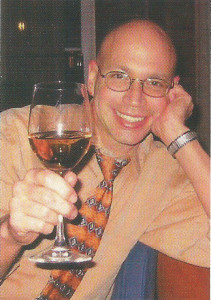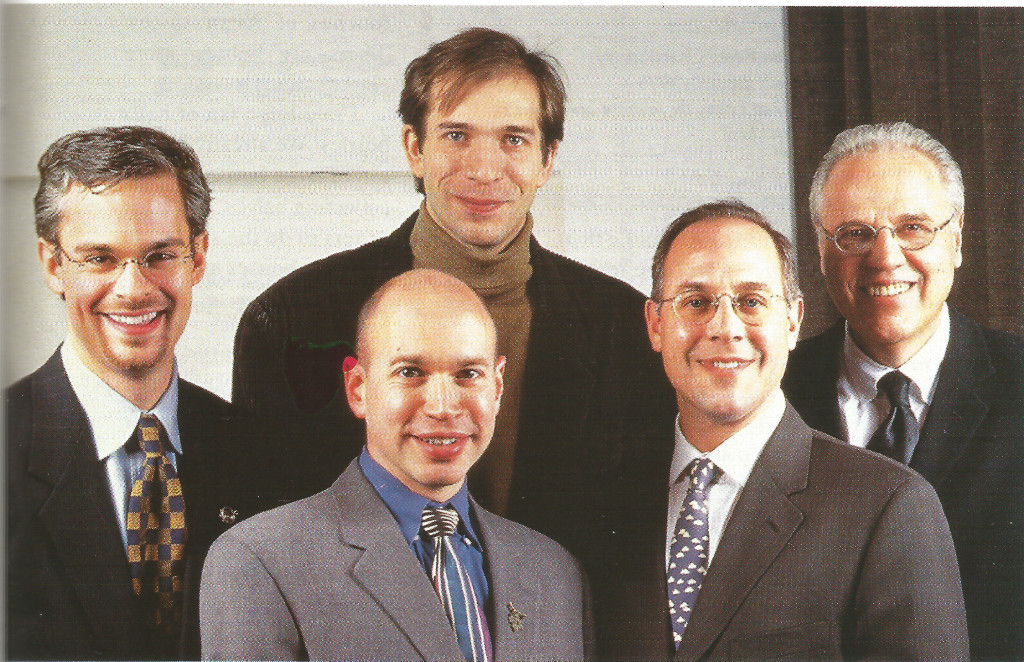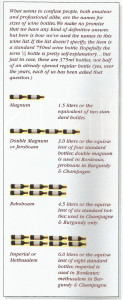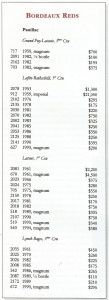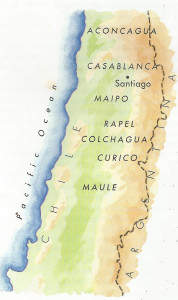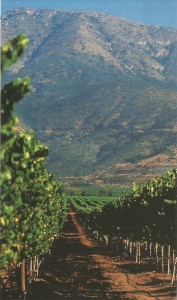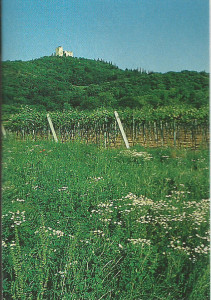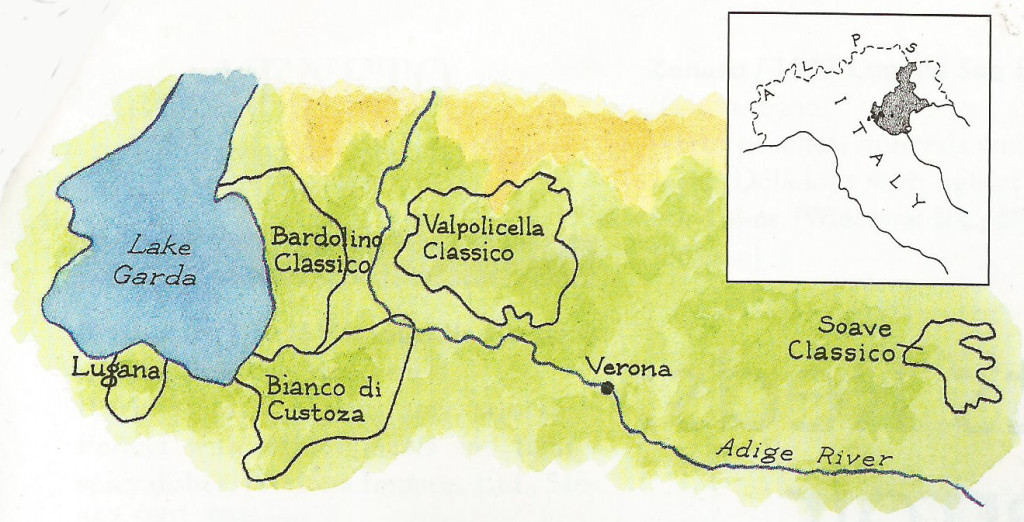Santé
The Magazine for Restaurant Professionals
November 1999
Pages 42-44, 91-97
Chianti: Robust and Reborn
I found myself more than a little put off as I read an article by a famed wine writer on the subject of Chianti. In it, he lauded the changes in denominazione di origine controllata e garantita (DOCG) laws and the winemaking in the region in general. The grist for his praise was the allowance of more Cabernet Sauvignon and Merlot in the Chianti blend, the introduction of new barriques and the elimination of “that Italian character.” “Finally,” he concluded, “Chianti might become a good wine.”
In many ways, I think that the new DOCG regulations are a good thing. Tighter controls on viticulture and vinification practices and attention to quality are all positive steps for this Tuscan region. I’m also all for the freedom of winemakers to choose their own paths and to offer new bottlings of wine for all of us to enjoy. But, as the cliché goes, let’s not throw out the baby with the bathwater.
The adage fits, too. We all remember Chiantis from decades past that were vaguely reminiscent of bathwater. Flooding the market, they served little more purpose than to provide a vehicle for ingesting alcohol. Chianti let us pretend to join the sophisticated world of wine drinking, and it provided wicker-covered fiaschi as candleholders for our apartments. The baby, however, has been, often is and hopefully will continue to be an elegant red wine worthy of its DOCG rating. With flavors of black cherries, black raspberries, wildflowers and smoked meats, the Sangiovese base of good Chianti makes delicious wine. There is certainly a market for the “international” style of red wine, but perhaps those are best left to non-DOCG categories.
What is Chianti?
General Characteristics
A Sangiovese-based red wine from the Tuscan hills surrounding the cities of Florence and Siena, Chianti can contain up to 25 percent of Canaiolo, Colorino, Malvasia Nera, Mammolo, Cabernet Sauvignon and Merlot, depending on the subzone. Flavors are generally those of black cherries, black raspberries, grilled or smoked meats and wildflowers.
Aging
Most Chiantis are made for fairly youthful drinking, within a year of release; however, many are quite age worthy. Some of the best, especially riservas from the Classico and Rufina zones, can age 40+ years.
Recent Vintages
1997 – Excellent vintage, potentially as good or better than 1990.
1996 – A bit more acidity than 1995, but similar in style.
1995 – Deep, well structured, made for the long haul.
1994 – Light and elegant, perfect for current consumption.
1993 – Bold, for-ward-fruit styles, favored for drinking now.
1992 – Simpler, lighter wines, generally past their prime.
1991 – Lighter, more elegant style, most are fading.
1990 – Excellent, long-lasting, big-style wines.
1989 – Good, very forward, many starting to fade.
1988 – Very good, well structured, drinking beautifully.
Tuscany’s Historic Wine
Chianti is a name that practically every restaurant diner recognizes, but how many customers know something about the wine? Part of our job as beverage managers is to inform our guests about wine, without making them feel stupid and without going into deep, technical detail. So here’s the basic scoop on Chianti.
First, it is an area of Tuscany in central Italy. Second, under the appellation system, it is also the name of the wine made in that place. Chianti has enjoyed a long history before the denomination system was established.
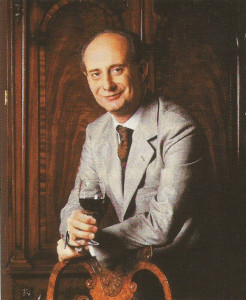
Leonardo Frescobaldi of Marchesi de Frescobaldi oversees a vast wine empire, including the prime Chianti Rufina property, Castello di Nipozzano.
In the mid-fourteenth century, the name came to be strongly associated with a specific type of Sangiovese-based wine. In the early 1700s, a Grand Ducal decree first outlined an exacting geographic region – a demarcation that was codified into law in 1932.
Chianti was one of the first Italian wine “successes,” largely due to strict enforcement of regulations by the League of Chianti. Specific blends of grapes were promoted, certain techniques of viticulture and vinification were introduced and a massive promotional campaign was put into play. The British, too, played a strong role; during one of many wars with France, wine drinkers sought an alternative to the then unavailable Bordeaux. Chianti was the drink of choice.
Chianti Classico
While there are many wines that are specifically of the Chianti DOCG, there are just as many or more that come from its subzones. There are eight subzones, each producing somewhat distinctive styles of Chianti. The most famous and largest of them is Chianti Classico, an area with its own separate DOCG that lies between Florence and Siena. The fame is largely due to the organization most of us think of as the Black Rooster or Gallo Nero. This servicemark of the Consorzio Chianti Classico is granted to wines that the consorzio judges to be of proper quality.
Not all Chianti Classico producers submit their wines to the consorzio. The judgement granted has often been controversial, with past accusations that, while the judges may wisely enforce minimum standards, they often unwisely enforce maximums as well. Simply put, some wines have been rejected as being “too immodest” to be Chianti Classico. These nonconforming producers have fought and won changes in the regulations over the last few years.
Classico also has its own unofficial appellation system, further dividing the region into eight communes: San Casiciano Val di Pesa, Greve, Radda, Gaiole, Castelnuovo Berardenga, Castellina, Barberino Val d’Elsa, Poggibonsi and Tavarnelle Val di Pesa, each claiming differing styles. Historically, this may be true, but the widespread changes to grape growing and winemaking practices have certainly lessened those differences. In general, the further north (toward Florence) the vineyards, the lighter the wines. Many of the most familiar and best Chianti producers come from this zone.
Not all Chianti Classico producers submit their wines to the consorzio… Simply put, some wines have been rejected as being “too immodest…”
Chianti Subzones
Less known, but not lesser in quality, are the other seven subzones. Covering the Tuscan provinces of Arezzo, Firenze, Pisa, Pistoia and Siena are the zones Rufina, Montalbano, Colline Pisane, Colli Senesi, Colli Fiorentini, Colli Aretini and the newest, Montespertoli. Each of these makes delightful Chianti; many are as powerful and age worthy as the more well-known Classicos. Marchesi de’ Frescobaldi at Castello di Nipozzano in Rufina heads the list of the many fine producers from these zones.
These regions generally have retained the more traditional blends of grape varieties, choosing to update viticulture and vinification techniques while retaining a classic style. These zones are also less well known, because many producers from these regions have opted to label their wines as Chianti; designating the subzone o the label is not required by law.

The sienese hills lie within the Chianti Colli Senesi zone, whose Chianti production is second only to Chianti Classico.
Classically, the Chianti blend is a majority of Saniovese, from 75-90 percent. Indigenous varietals Canaiolo Nero and Colorino make up five to ten percent, and two white grapes, Trebbiano and Malvasia, comprise five to ten percent combined (two to five percent for Classico). While these standards remain the official blend throughout the Chianti DOC and seven other subzones, Chianti Classico now allows more latitude in grape choices and percentages, including Cabernet and Merlot, and even allows the wine to be up to 100 percent Sangiovese. Before release, wines must be aged 2-2½ years depending on the subzone, including three months in bottle. Oak maturation is not required. Each of the regions, including Classico and Chianti itself, allows a
riserva, requiring an additional year of aging before release.
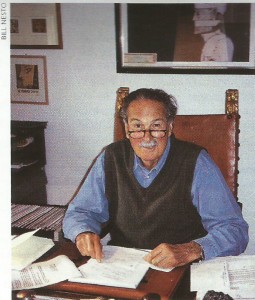
Innovator and iconoclast Sergio Manetti has dropped Chianti Classico from his label, preferring to use the Vino da Tavola designation and the Monte Vertine estate name only.
, a traditional procedure in Chianti, is a proces of reserving 10-15 percent of early-harvested grapes and allowing them to air-dry before adding them into the already fermented Chianti to induce a second fermentation. A “rigoverno” also is allowed, with a further percentage of grapes used to induce a third fermentation. Most producers employ the method to make their young Chianti sweeter.
Governo has become less common, as many producers believe that it lessens a wine’s ability to age. Anecdotal data suggests otherwise, and some producers maintain the practice (e.g., Ruffino’s famed Ducale Oro riserva).
As with much of the landscape of Tuscany, the base soil of Chianti is schistose clay. Depending on subzone and commune, there are various additions of flint, limestone, fossilized marine shells and sand. Sangiovese is a fairly hardy vine and is well adapted to these hard, mineral soils. In my view, the mineral elements add something to the flavor of the final products as well. Generally, the best vineyards contain a flaky marl known as galestro that is easily cracked and crumbled into fragments.
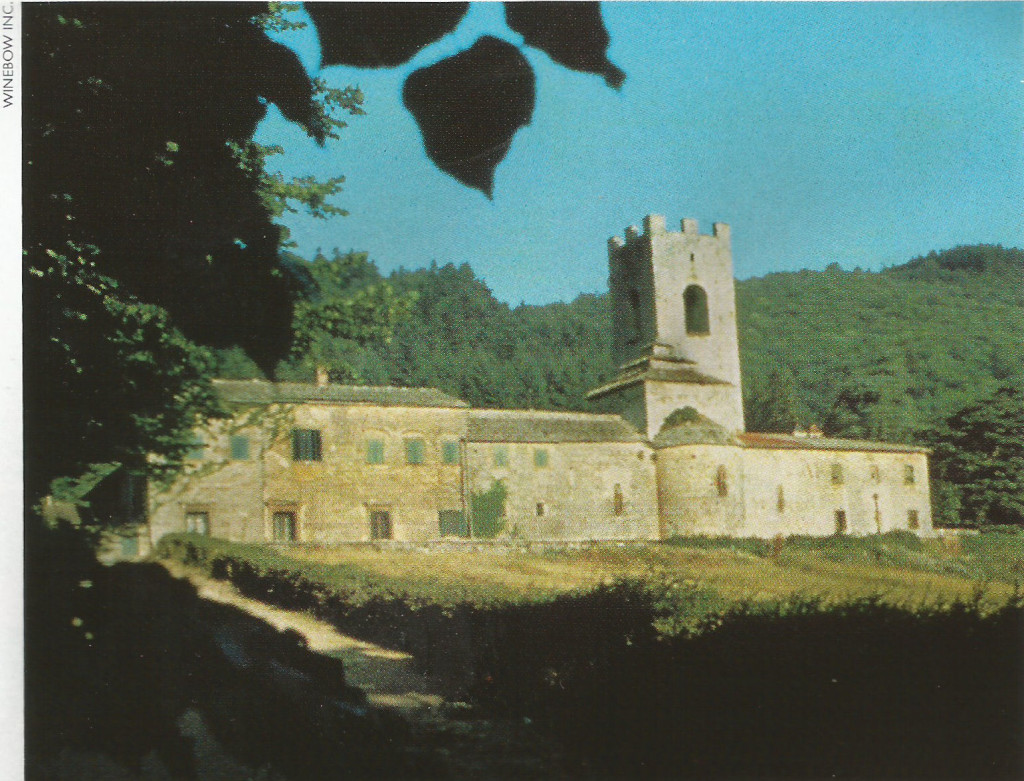
A landmark in the Chianti Classico zone, the abbey at Badia a Coltibuno (Abbey of the Good Harvest) is home to fine Chiantis made by integrating traditional with modern techniques.
The many changes in the Chianti vineyards and wineries and in the wine laws have raised the standard of this Tuscan classic. It’s only my opinion, but I say let’s keep Chianti traditions that make sense; Sangiovese and small amounts of local grapes; perhaps a bit of Cabernet here and there, but not in large doses; a little
governo now and again; and maybe even an occasional
fiasco covered in wicker. Chianti doesn’t need to taste as if it came from Napa.
Reviewer’s Choice
Cennatoio / 1995 Chianti Classico Riserva, O’Leandro
Cinnamon, black cherry, dark chocolate fudge, very intense. Possibly the best Chianti tasted. Stunning on its own or with game meats.
Lilliano / 1997 Chianti Classico
Earthy, dark fruit, smoky and spicy, well balanced; long finish. Perfect with grilled meats.
Renzo Masi / 1996 Chianti Rùfina Riserva
Blackberries, dark chocolate, light spice and oak. Perfect with roasted venison or wild boar.
Chianti
VALUE
Badia a Coltibuono / 1997 Cetamura
90% Sangiovese, 10% Canaiolo
Fruity style, with black raspberry and lightly smoked meat flavors. Mildly spiced Mediterranean fare. [Winebow, Inc., 201-445-0620, $96/case]
Castello di Querceto / 1997
85% Sangiovese, 10% Canaiolo, 5% Malvasia & Trebbiano
Black raspberries, pepper and clove and light oak aromas and tastes. A nice match with light pork dishes. [Prestige Wine Imports Corp., 212-465-1857, $58/case]
Cecchi / 1997
75-90% Sangiovese, 5-10% Canaiolo, 5-10% Trebbiano & Malvasia
Aromas and tastes of cherries, with a note of salami. Perfect as a lunch/sandwich Chianti. [Banfi Vintners, 800-645-6511, $74/case]
Col d’Orcia / 1996 Gienprone
95% Sangiovese, 5% local grape varieties
Earthy, with bittersweet chocolate and light cherry fruit. A good choice with grilled dishes. [Frederick Wildman & Sons, Ltd., 212-355-0770, $66/case]
Spalletti / 1997
90% Sangiovese, 5% Canaiolo, 5% Trebbiano
Aromas and flavors of cherries and slightly smoked meat, with light floral notes. A classic “spaghetti” Chianti. [Kobrand Corporation, 212-490-9300, $80/case]
Straccali / 1997
85% Sangiovese, 10% Canaiolo, 5% Malvasia and Trebbiano
Wild cherry cough drops, with light spice. A good house pour candidate. [Palm Bay Imports, Inc., 800-872-5622, $60/case]
MODERATE
Cantina di Montalcino / 1995 Riserva
100% Sangiovese
Aromas and tastes of mortadella, cherries and spice, with a touch of oak. Very nicely made. Perfect with roasted pork. [Winewave, Inc., 516-433-1121, $102/case]
Gabbiano / 1997
87% Sangiovese, 6% Canaiolo, 5% Trebbiano, 2% Colorino
Black raspberries, oak, cocoa and floral overtones. Perfect with pork dishes. [Beringer Wine Estates, 707-963-7115, $110/case]
Fattoria di Piazzano / 1996 Rio Camerata
Sangiovese, Canaiolo, Cigliegiolo and Casentino
Black raspberry, milk chocolate and light spice aromas and flavors. The standout of the basic Chiantis. Great with roasted pork. [Michael Skurnik Wines, 516-677-9300, $104/case]
Fattoria di Piazzano / 1995 Riserva Rio Camerata
100% Sangiovese
Medium-bodied, with amarene cherries, dark chocolate and cinnamon. Roasted game birds. [Michael Skurnik Wines, 516-677-9300, $144/case]
Chianti Classico
VALUE
Ottosanti by Briante / 1997
75-90% Sangiovese, 5-10% Canaiolo, 2-5% Malvasia and Trebbiano
Earthy and slightly oaky, with dark fruit, spice and bittersweet chocolate. A great choice with game. [Angelini Wine, Ltd., 860-444-7888, $96/case]
Castello di Querceto / 1996
88% Sangiovese, 10% Canaiolo, 2% other
Well balanced, with black cherry, grilled sausage and light spice aromas and tastes. Perfect with grilled meats. [Prestige Wine Imports Corp., 212-465-1857, $79/case]
MODERATE
Banfi / 1995 Riserva
80% Sangiovese, 10% Canaiolo, 10% Cabernet Sauvignon
Rather tightly wrapped anda bit hot, with some black raspberry fruit showing. Needs time. This will be a superb game wine. [Banfi Vintners, 800-645-6511, $128/case]
Bucciarelli / 1996
80% Sangiovese, 15% Canaiolo, 5% Malvasia
Aromas and flavors of dark cherry, black tea and a touch of salami. Perfect with cured and smoked meats. [Panebianco, 212-685-7560, $144/case]
Villa Cafaggio / 1997
predominately Sangiovese
Dark chocolate, black cherry and slightly smoky scents and flavors. A choice for lighter red meat dishes. [F&F Fine Wines International, Inc., 201-935-5935, $128/case]
Casavecchia di Puiatti / 1995 Il Sogno
100% Sangiovese
Bright blackberry fruit, mixed spices and lightly oaked; long finish. Red meat dishes. [Vin DiVino, Ltd., 773-334-6700, $140/case]
Castelli del Grevepesa / 1997 Clemente VII
90% Sangiovese, 10% Canaiolo
Black cherry, milk chocolate and light spice. Works nicely with poultry dishes. [Angelini Wine, Ltd., 860-444-7888, $104/case]
Castello d’Albola / 1997
90% Sangiovese, 8% Canaiolo, 1% Trebbiano, 1% Malvasia
Scents and flavors of black raspberry soda and fruit, with bright acidity. Spicy seafood dishes. [Seagram Chateau & Estate Wines Co., 707-942-3400, $120/case]
Castello di Brolio / 1996
90% Sangiovese, 8% Canaiolo, 2% Malvasia
Scents and flavors of dried fruit, dark cherries and black tea; long finish. Perfect with lighter game. [Brown-Forman Beverages Worldwide, 502-585-1100, $144/case]
Castello di Monastero / 1997
85% Sangiovese Grosso, 15% Merlot and Cabernet Sauvignon
Penetrating nose of ripe black cherry, with vanilla, cocoa and floral notes. Well balanced, good structure, with mostly soft tannins and excellent, ripe cherry-berry fruit, persistent and pleasing finish. Tomato-based pasta dishes. [Vinum International, 707-224-9601, $135/case]
Castello di Querceto / 1995 Riserva
88% Sangiovese, 10% Canaiolo, 2% other
Black raspberries, pepper and clove, oakey and somewhat light. Venison would be a first choice. [Prestige Wine Imports Corp., 212-465-1857, $144/case]
Castello Vicchiomaggio / 1997 San Jacopo da Vicchiomaggio
90% Sangiovese, 5% Canaiolo, 5% Colorino
Still young, with bright, black raspberry fruit and spice scents and flavors. Just right for roasted pork. [The Hess Collection Winery, 707-255-1144, $129/case]
Dievole / 1996
65% Sangiovese, 15% Malvasia, 10% Canaiolo, 10% Colorino
Soft, with milk chocolate, pepper and moderate oak. Grilled red meats. [Terroir Brands, 727-787-0099, $120/case]
Isole e Olena / 1997
Sangiovese and Canaiolo
Dark cherry fruit and grilled meat, with earthy notes. Venison or boar. [Martin Scott Wines, Ltd. (New York only!), 516-327-0808; In other regions call Paolo de Marchi, Isole e Olena, Italy, 011-39-55-807-2763, $144/case]
Lilliano / 1997
80% Sangiovese, 20% Canaiolo
Earthy, dark fruit, smoky and spicy, well balanced; long finish. Perfect with grilled meats. [Premium Brands, Inc., 718-263-4094, $104/case]
Nozzole / 1994 Riserva
91% Sangiovese, 7% Canaiolo and Colorino, 2% Trebbiano
Juicy, dark cherry fruit, earthy and nicely balanced. A nice choice with roast beef. [Kobrand Corp., 212-490-9300, $118/case]
Podere Le Cinciole / 1996 Le Cinciole
90% Sangiovese, 8% Canaiolo, 2% Colorino
Earthy, with dark chocolate and black cherry scents and tastes. Young, but drinking well. A steak wine. [Michael Skurnik Wines, 516-677-9300, $144/case]
Querciavalle / 1994
80% Sangiovese, 20% Canaiolo
Black raspberry and light spice, with toasty, yeasty notes. Poultry dishes. [Tricana Imports, Inc., 516-935-4080, $128/case]
Teuta di Riseccoli / 1995
98% Sangiovese, 2% Cabernet Sauvignon
Light cherry and spice aromas and flavors, simple. A good choice for poultry. [Vias Imports, Ltd., 800-936-6125, $128/case]
Fattoria di Rodano / 1996
100% Sangiovese
Black cherry soda and a touch of pepperoncino. Young. A great pasta wine. [Summa Vitis, 415-922-3241, $132/case]
PRESTIGE
Antinori / 1996 Peppoli
90% Sangiovese, 10% Merlot
Medium-bodied, with dark chocolate, gravel and clove aromas and flavors. A classic match for osso buco. [Rémy Amerique, 212-399-4200, $180/case]
Badia a Coltibuono / 1997
90% Sangiovese, 10% Canaiolo
Dark raspberry and cherry fruit flavors, with light spice notes. Pasta, with cream or mushroom sauces. [Winebow, Inc., 201-445-0620, $164/case]
Badia a Coltibuono / 1997 >Roberto Stucchi Signature
100% Sangiovese
Very floral nose. Smooth, dark raspberry and cherry fruit flavors. Pork roast. [Winebow, Inc., 201-445-0620, $152/case]
Borgo Salcetino / 1996 Salcineto
95% Sangiovese, 5% Canaiolo
Black raspberry, spice and fairly tannic; long finish. Needs time. Perfect with game. [Angelini Wine, Ltd., 860-444-7888, $176/case]
Bucciarelli / 1994 Riserva
80% Sangiovese, 15% Canaiolo, 5% Malvasia
Scents and flavors of spearmint, dark cherry, white pepper and a touch of graham. Definitely a lamb choice. [Panebianco, 212-685-7560, $180/case]
Castellare / 1997
90% Sangiovese, 10% Canaiolo
Moderately floral nose. Cherry fruit and spice flavors. Roasted veal chops. [Winebow, Inc., 201-445-0620, $160/case]
Castello dei Rampolla / 1995 Riserva
90% Sangiovese, 10% Cabernet Sauvignon
Spicy and very floral, with dark chocolate and a touch of dark cherry fruit. Lighter game dishes. [Vias Imports, Ltd., 800-936-6125, $288/case]
Castello della Paneretta / 1994 Riserva
100% Sangiovese
Still young, with black cherry, white pepper and a touch of tannin. Excellent choice for grilled red meats. [Summa Vitis, 415-922-3241, $180/case]
Castello di Brolio / 1994 Riserva
100% Sangiovese
Very ripe and fragrant bery fruit, with clove, toasty oak, leather, tar and chocolate notes. Full-bodied, with lush and round berry fruit, great acidity and black pepper notes; long and lush finish. Rich, fatty roasts of lamb or beef. [Brown-Forman Beverages Worldwide, 502-585-1100, $153/case]
Castello di Fonterutoli / 1995 Riserva
90% Sangiovese, 10% Cabernet Sauvignon
Closed, with spicy, ginger and dark fruit scents and tastes. Great with game meat. [Empson USA, Inc., 703-684-0900, $359/case]
Castello di Querceto / 1994 Riserva Il Picchio
88% Sangiovese, 10% Canaiolo, 2% other
Black raspberries, salami, light spice and floral elements. Serve with grilled or smoked dishes. [Prestige Wine Imports Corporation, 212-465-1857, $265/case]
Castello di Verrazzano / 1996
85% Sangiovese, 10% Canaiolo and Mammolo, 5% Trebbiano and Malvasia
Dark cherry, very spicy and well balanced. Will work well with sweet fruit sauces on meats. [Palm Bay Imports, Inc., 800-872-5622, $200/case]
Castello di Verrazzano / 1995 Riserva
85% Sangiovese, 10% Canaiolo and Mammolo, 5% Trebbiano and Malvasia
Very spicy and slightly smoky, with intense raspberry fruit. Braised beef dishes. [Palm Bay Imports, Inc., 800-872-5622, $312/case]
Castello Vicchiomaggio / 1994 Riserva La Prima
92% Sangiovese, 5% Canaiolo, 3% Colorino
Chocolaty, dark cherry fruit and spicy aromas and flavors; long finish. Lamb is a prime choice. [The Hess Collection Winery, 707-255-1144, $290/case]
Castello Vicchiomaggio / 1994 Riserva Petri
88% Sangiovese, 5% Canaiolo, 5% Cabernet, 2% Trebbiano
Floral, with dark cherry fruit and light spice; nice finish. Perfect with game birds.. [The Hess Collection Winery, 707-255-1144, $225/case]
Cecchi / 1995 Riserva Villa Cerna
75-90% Sangiovese, 5-10% Canaiolo, 5-10% Trebbiano, 2-5% Malvasia
Smoked meat, dark chocolate and black raspberry aromas and flavors; great length. Anything off the grill works here. [Banfi Vintners, 800-645-6511, $148/case]
Cecchi / 1993 Riserva Messer Pietro di Teuzzo
90% Sangiovese, 10% Canaiolo and Colorino
Graham and honey, with wildflowers, dark cherries and light earthy tones. Perfect with roasted veal chops. [Banfi Vintners, 800-645-6511, $108/6 bottles]
Cennatoio / 1996
90% Sangiovese, 7% Canaiolo, 3% Colorino
Rich and full, with black cherry, ginger and bitter chocolate. Just right with game birds. [Panebianco, 212-685-7560, $180/case]
Cennatoio / 1995 Riserva
90% Sangiovese, 7% Canaiolo, 3% Colorino
Full and rich, with five spice powder, black cherry and dark chocolate aromas and flavors. An incredible choice with braised beef or game. [Panebianco, 212-685-7560, $300/case]
Cennatoio / 1995 Riserva O’Leandro
90% Sangiovese, 7% Canaiolo, 3% Colorino
FCinnamon, black cherry, dark chocolate fudge, very intense. Possibly the best Chianti tasted. Stunning on its own or with game meats. [Panebianco, 212-685-7560, $348/case]
Dievole / 1995 Riserva
65% Sangiovese, 15% Malvasia, 10% Canaiolo, 10% Colorino
Full-bodied, with dark chocolate, juicy cherry fruit and sweet oak. Beautiful with lamb. [Terroir Brands, 727-787-0099, $176/case]
Dievole / 194 Novecento
65% Sangiovese, 15% Malvasia, 10% Canaiolo, 10% Colorino
Dark cherry and “stewed” fruit nose, with vanilla and citrus rind notes. Excellent balance, rich and full-bodied, with lush black cherry fruit and great acidity; long, pleasing finish. Elegant wine for beef tenderloin. [Terroir Brands, 727-787-0099, $232/case]
Il Vescovino / 1996 Vigna Piccola
85% Sangiovese, 15% Canaiolo, Malvaisa and Colorino
Mature, sweet aromas of black cherry, with citrus rind topnote. Well balanced, medium-bodied and silky, wiht ripe black cherry flavors, a hint of smoke and a pleasing sharpness; good finish, with fruity notes. Spicy Mediterranean fare or grilled meats. [Winebow, Inc., 201-445-0620, $148/case]
Monsanto / 1995 Riserva
90% Sangiovese, 7% Canaiolo, 3% Colorino
Well balanced, with aromas and flavors of smoked meat, dark cherries and spices. One of my favorites. Perfect with steak. [Cliquot, Inc., 212-888-7575, $168/case]
Monsanto / 1995 Riserva Il Poggio
90% Sangiovese, 7% Canaiolo, 3% Colorino
Highly perfumed, wiht dark fruit and great structure. Roast shoulder of veal works here. [Cliquot, Inc., 212-888-7575, $345/case]
Podere Il Palazzino / 1995 Grosso Sanese
100% Sangiovese
Complex nose, with mature black cherry, clove, chocolate and cedar aromas. Outstanding balance and finesse, with rich, ripe berry flavors on a mantle of new oak; long, silky finish. A wine in harmony. Beef tenderloin or lamb. [Michael Skurnik Wines, 516-677-9300, $280/case]
Podere la Cappella / 1994 Riserva Querciolo
100% Sangiovese
Well balanced, with grilled meat and cherry aromas and tastes. Perfect with steaks. [Selected Estates of Europe, 914-698-7202, $170/case]
Podere Le Cinciole / 1995 Riserva Valle del Pozzo
90% Sangiovese, 8% Canaiolo, 2% Colorino
Aromas and flavors of black raspberries and spice; great length and finish. Roasted pork would be a first choice. [Michael Skurnik Wines, 516-677-9300, $196/case]
Poggio dei Poggi / 1995 Le Bolle
85% Sangiovese, 15% Cabernet Sauvignon
Chocolate, cherries and a touch of mint. Quite well made. Delightful with lamb. [Fedway Imports Co., 516-74-6850, $160/case]
Poggio dei Poggi / 1994 Riserva
100% Sangiovese
Black raspberry jam, toast, yeast and bright acidity. Just right with roasted pork. [Fedway Imports Co., 516-74-6850, $168/case]
Querciavalle / 1993 Riserva
80% Sangiovese, 20% Canaiolo
Milk chocolate, red cherries and light spice, with moderate oak. Veal would be a great match. [Tricana Imports, Inc., 516-935-4080, $192/case]
Rocca delle Macie / 1995 Riserva Fizzano
90% Sangiovese, 5% Canaiolo, 5% Cabernet Sauvignon and Merlot
Bright raspberry fruit, with lots of earthy tones, light spice and herbal touches. Perfect with game birds. [Palm Bay Imports, Inc., 800-872-5622, $200/case]
Rocca di Castagnoli / 1996
95% Sangiovese, 5% Canaiolo
Pleasing, ripe black cherry nose, with floral, spice and clove notes. Medium-bodied and well made, with silky black cherry flavors; long finish. [Vias Imports, Ltd., 800-936-6125, $160/case]
Rocca di Montegrossi / 1997
90% Sangiovese, 10% Canaiolo
Big and bold, with black cherry, dark chocolate, spice and floral scents and flavors. Game meats. [Michael Skurnik Wines, 516-677-9300, $148/case]
Fattoria di Rodano / 1995 Riserva Viacosta
100% Sangiovese
Very young, tannic and closed, with dark cherry fruit, bitter chocolate and pepper aromas and flavors. An excellent choice for a roast. [Summa Vitis, 415-922-3241, $216/case]
Ruffino / 1995 Riserva Ducale
100% Sangiovese
Deep, dark cherry aroma, with clove, floral and smoky bacon notes. Medium-bodied, with lots of dark, almost sweet, fruit flavors balanced by acidity; hot finish, with a black pepper note. Grilled steaks. [Schieffelin & Somerset, 212-251-8200, $162/case]
Ruffino / 1993 Riserva Ducale, Gold Label
100% Sangiovese
Beautiful nose of pure, ripe black cherry, with some leather, citrus and floral notes. Medium-bodied, wiht black cherry/raspberry flavors and chocolate, citrus rind notes; sweet fruit and zippy acidity in the finish. A crowd pleaser. [Schieffelin & Somerset, 212-251-8200, $333/case]
Ruffino / 1996 Santedame
100% Sangiovese
Fragrant, with ripe black cherry and malted chocolate aromas. Medium-bodied, soft and round black cherry flavors and a good crispness; pleasant finish. Easy drinking. Tomato-based dishes or spicy vegetarian fare. [Schieffelin & Somerset, 212-251-8200, $126/case]
San Leonino / 1995 Monsenese
90% Sangiovese, 5% Canaiolo, 5% Cabernet Sauvignon
Aromas and flavors of chocolate-covered cherries in liqueur and spice, with soft tannins. Perfect with roasted pork. [Wilson Daniels, Ltd., 707-963-9661, $180/6 bottles]
Fattoria di Vignamaggio / 1995 Riserva Monna Lisa
100% Sangiovese
Classic style, light, elegant and well balanced, with black cherries. Great with mushroom dishes. [Parliament Wine, 609-348-1100, $200/case]
Chianti Rufina
VALUE
Renzo Masi / 1997
92% Sangiovese, 5% Canaiolo, 3% Colorino
Lovely, clean and fragrant nose of black cherry fruit. Medium-bodied, with soft tannins, ripe, sour cherry flavors and good balance between fruit and acid; modest and clean finish. Simple, direct and very pleasant. Tomato-based pasta dishes. [Premier Wine Merchants/Rémy Amerique, Inc., 212-399-4200, $72/case]
Renzo Masi / 1996 Riserva
93% Sangiovese, 5% Canaiolo, 2% Colorino
Blackberries, dark chocolate, light spice and oak. Perfect with roasted venison or wild boar. [Premier Wine Merchants/Rémy Amerique, Inc., 212-399-4200, $80/case]
MODERATE
Colognole / 1995
95% Sangiovese, 5% Colorino
Well balanced, light and floral, wiht black cherry fruit. Excellent choice for veal. [Vin DiVino, Ltd., 774-334-6700, $114/case]
Spalletti / 1993 Riserva Poggio Reale
90% Sangiovese, 5% Canaiolo, 5% Trebbiano
Earthy, black pepper, leather and dark fruit scents and tastes. Any roasted game. [Kobrand Corp., 212-40-9300, $106/case]
PRESTIGE
Marchesi de’ Frescobaldi / 1996 Riserva Montesodi
100% Sangiovese
Elegant and spicy, with amarene cherry; long finish. Always a favorite. Venison or lamb is perfect. [Paterno Imports, 847-604-8900, $212/6 bottles]
Marchesi de’ Frescobaldi / 1996 Riserva Nipozzano
90% Sangiovese, 10% minor varieties
Well balanced, with dark chocolate, black cherries and gravelly aromas and flavors. One of the “greats.” Perfect with lamb. [Paterno Imports, 847-604-8900, $180/case]
Other Chianti Zones
VALUE
Cantina dell’Aretino / 1997 Chianti Colli Aretini Vasari
75% Sangiovese, 10% Canaiolo, 5% Malvasia, 5% Trebbiano, 5% Cabernet Sauvignon
Earthy, graham, black raspberry and cocoa flavors and aromas. Poultry or pork. [Tricana Imports, Inc., 516-935-4050, $88/case]
Tenuta di Capezzana / 1996 Chianti Montalbano
80% Sangiovese, 10% Canaiolo, 10% other varieties
Bright, black raspberry fruit, light spice and yeasty, with higher acidity. Perfect with poultry and vegetable dishes. [Cliquot, Inc., 212-888-7575, $93/case]
Falchini / 1997 Chianti Colli Senesi Titolato Colombaia
85% Sangiovese, 15% Canaiolo and other varieties
Well balanced and lightly oaked, with salami and black raspberries. A niche choice with veal. [Bedford International, 914-833-2725, $84/case]
Geografico / 1997 Chianti Colli Senesi
85% Sangiovese, 10% Canaiolo, 5% Trebbiano and Malvasia
Nicely balanced and fruity, with fresh cherries and a touch of oak. A perfect fish Chianti. [Matt Brothers, 212-587-8147, $80/case]
Fattoria di Luicgnano / 1997 Chianti Colli Fiorentini
Sangiovese, Canaiolo and Trebbiano
Nicely structured, with cherry, milk chocolate, light spice and oak aromas and flavors. Works well with veal dishes. [Michael Skurnik Wines, 516-677-9300, $88/case]
San Luigi / 1995 Chianti Colli Senesi
90% Sangiovese, 10% Canaiolo
Earthy and highly perfumed, with raspberries; slightly acidic finish. Great choice with poultry. [MPM Wine Imports, 212-989-8046, $96/case]
Fattoria Sovestro / 1997 Chianti Colli Senesi San Domenico
75% Sangiovese, 15% Malvasia, 10% Canaiolo
Good depth and nicely balanced, with moderate to heavy oak, black cherry and vanilla aromas and flavors. Lighter pork dishes. [Vias Imports, Ltd., 800-936-6125, $96/case]
MODERATE
Poggio Salvi / 1997 Chianti Colli Senesi
90% Sangiovese, 10% Canaiolo, Colorino, Merlot and Malvasia
Full-bodied, with soft tannins and aromas and flavors of green olives, dark cherries and a touch of mortadella. For a Senesi, this is a great choice for roasts. [Panebianco, 212-685-7560, $114/case]
Vagnoni / 1996 Chianti Colli Senesi
80% Sangiovese, 15% Canaiolo, 5% Trebbiano
Very well balanced, with juicy black cherry fruit, cocoa and spice. Excellent, a favorite. Pork dishes. [Tricana Imports, Inc., 516-935-4080, $100/case]
Vagnoni / 1995 Chianti Colli Senesi Riserva
Sangiovese, Canaiolo and Trebbiano
Young but balanced, with rich, bitter chocolate, black cherries and spice. Lamb dishes. [Tricana Imports, Inc., 516-935-4080, $112/case]
Santé is a glossy format trade magazine for restaurant wine buyers and educators. I wrote as a freelancer for them on and off from the first issue in November 1996 until November 2002 when they decided to stop using freelance writers.





